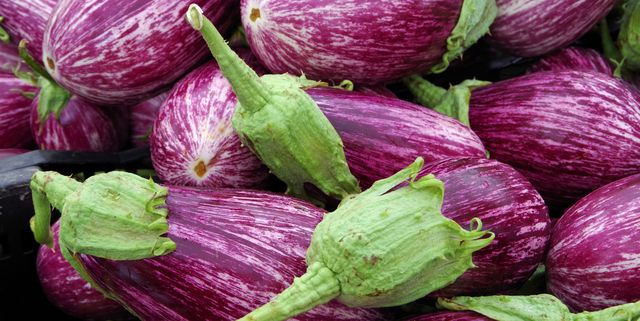The range of sizes, shapes, and colors of the heat-loving eggplant (Solanum melongena) tells the story of its enduring popularity. Native to India, where it grows wild, it has been cultivated in Southeast Asia for thousands of years.
Europe was introduced to the vegetable in the 8th century via the Moors, who brought it to Spain, Sicily, and southern France via North Africa. In the sunny, dry climate of the Mediterranean basin, eggplant found the warm growing conditions it prefers and soon found its way into the classic cuisines of the region.
A classic eggplant is deep purple and pear-shaped, but when you grow your own, you can try a cornucopia of other colors and shapes, from elongated lavender-and-white Fairy Tale to the round, violet-blushed Rosa Bianca. But to succeed with eggplants, you'll need to supply them with steadily warm growing conditions for at least three months. Eggplants growing in cold soil or exposed to chilly weather will sulk and potentially suffer from insect and disease problems.
Planting Eggplant
Give eggplants a head start on the growing season by starting them indoors, six to nine weeks before the average last frost. Soak seeds overnight to encourage germination; sow them ¼ inch deep in a loose, fine medium, such as vermiculite. Use bottom heat to maintain a soil temperature of 80 to 90 degrees for the eight to 10 days required for sprouting.
Transplant seedlings to individual pots once they reach 3 inches. When outside nighttime air temperatures are above 50 degrees, gradually expose them to the outdoors to harden them off. Keep transplanting your seedlings into larger pots as you wait for both outdoor air and soil to warm up to at least 70 degrees.
Try growing eggplants in raised beds, which heat up quickly in spring. Plants given plenty of room are healthier and more productive, so space them 2½ to 3 feet apart in all directions. Water well, pour 1 to 2 cups of compost around each plant, and firm the soil gently.
Eggplants are also good for container growing, with one plant per 5-gallon pot.
Growing Eggplants
Mulch immediately after transplanting, and gently hand pull any invading weeds. Interplant an early crop, such as lettuce, between the eggplant transplants. When the first set of flowers emerge, pinch them off. In addition to making the plant develop several fruiting branches, this will encourage the plant to put more energy into creating leaves and roots instead of one big fruit. To keep plants upright and fruit clean and intact, stalk plants with bamboo poles.
Weeding around the young transplants is essential. Weeds will outcompete eggplants until warm summer temperatures come. Stay on top of weeds by regularly hand-pulling or carefully weeding with a hoe or cultivator. Once the soil is warmed up, a mulch of straw or compost can be used. Grass clippings make a good anti-weed barrier, too.
Eggplant Problems
Flea beetles, which chew many tiny holes in leaves, are eggplant's worst pest. To avoid this problem, keep plants indoors until early summer, or cover outdoor plants with floating row cover or dust the foliage with kaolin clay (re-apply it after rain). If plants become infested, spraying Beauveria bassiana or spinosad may knock back the population of flea beetles and save your plants. When eggplants are grown in containers that are at least a foot-and-a-half off the ground, the flea beetles don't seem to find them as easily.
Hand pick and destroy yellow-and-black-striped Colorado potato beetles and the yellow masses of eggs they lay on leaf undersides. Hand picking is also effective for tomato hornworms, 4-inch green caterpillars with white stripes. Don't destroy those covered with tiny white cocoons; these contain the parasitic offspring of the beneficial braconid wasp. Tiny spider mites cause yellow-stippled leaves; control these pests by knocking them off the plant with a spray of water.
The most common eggplant disease is Verticillium wilt. Avoid it by planting resistant cultivars and by rotating crops.
Placing a floating row cover over seedlings right after planting offers a twofold benefit: It forms a physical barrier between the plants and insect pests, and the row cover acts as a greenhouse, heating the air around the plants above the ambient temperature. This lightweight, nonwoven material can be draped directly onto the plants or tented over the row, supported by wire hoops.
Harvesting Eggplants
Pick eggplant when the skin takes on a high gloss. To test, press the skin. If the indentation doesn't spring back, that fruit is ready for harvest. To harvest, clip the eggplants off the plant with pruning shears, keeping the cap and about 1 inch of stem intact. Watch out for the small prickles that line the stems and the cap of some varieties, as they are a skin irritant.
Eggplants will keep for two weeks if refrigerated. If you cut open an eggplant fruit and find that the seeds inside have turned brown, the fruit is past prime quality and the flavor may be bitter. The best way to avoid this is by picking fruits on the young side, when they are a third to two-thirds of their fully mature size.













